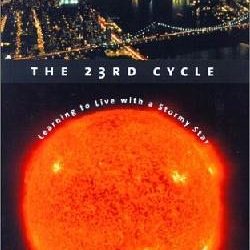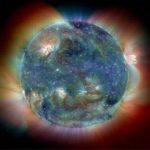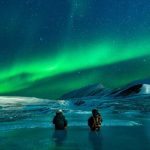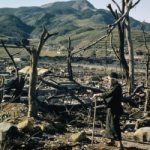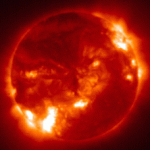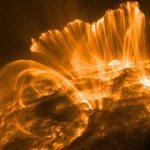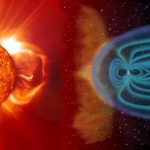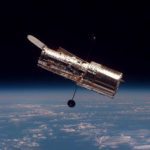Chapter 1: “A Conflagration of Storms”
Allen, Joe. 1990. 1989 solar activity and its consequences at Earth and in space. Seventh Symposium on Single Event Effects Conference. April 24-25, 1990. Los Angeles.
Broad, William. 1989. Space shuttle problem could cut flight short”, The New York Times, March 15, 1989 p. A16.
Boston Globe Staff. Quebec blackout halts power for 3 million. The Boston Globe. March 14, 1989 p.6.
Curran, Peggy. 1989. Hydro blames sun for power failure. The Montreal Gazette. March 14, 1989 p.1.
—— 1989. Hydro execs start post-mortem on huge blackout. The Montreal Gazette. March 15, 1989 A3.
Fairbanks Daily News Staff. 1989. Solar flare possibly the biggest ever recorded. The Fairbanks Daily News, March 12, 1989 p. E10.
—— 1989. Solar storm sets night skies afire. The Fairbanks Daily News. March 14, 1989 p.3.
Fisher, Lawrence. 1997. Failure of AT&T satellite will alter deal with Loral. The New York Times. January 18, 1997 p. 36.
Johnson, Jason. 1997. Power failure throws stadium for a loop. The Boston Herald. January 13, 1997 p. 7.
Kappenman, John. 1990. Bracing for the geomagnetic storms. IEEE Spectrum. March 1990. P. 27-32.
Los Angeles Times Staff. 1997. AT&T working to regain link with satellite: Telecom Telstar 401 is part of communications business to be sold to Loral for $712.5 million. The Los Angeles Times. January 15, 1997 p1.
Montreal Gazette Staff. 1989. 11-hour power failure stopped the presses. The Montreal Gazette. March 12, 1989 p. A3.
—— 1989. Hydros export clients lend a hand with power. The Montreal Gazette. March 14, 1989 A3.
New York Times Staff. 1989. Large solar flare erupts anew”, The New York Times, March 13, 1989 p.1.
Orlando Sentinel Staff. 1997. AT&T moves signals after satellite halts broadcast. The Orlando Sentinel. January 12, 1997 p.A22.
Perera, Judith. 1989. March flares mark solar unrest. New Scientist, 25 March 1989.
Rinehart, Steve. 1989. Light Show amazes, worries, Lower 48 watchers”, The Anchorage Daily News, March 15, 1989 p.B11.
Showstack, Randy. 1998. Upcoming solar maximum could affect wide range of technologies. EOS Transactions. 79:601
Toronto Star Staff. 1989. Huge storms on Sun linked to blackout that crippled Quebec”, Toronto Star, March 13 1989 p. A3
Vestner, Charlie. 1998. The sky’s the limit:In the 21st century satellites will connect the globe. Individual Investor. June 1998,. pp. 56-64.
Chapter 2: “Dancing in the Light”
Anselmo, Joseph, Solar storm eyed as satellite killer. Aviation Week and Space Technology, January 27, 1997, p. 61.
Bone, Neil. 1996. The aurora: Sun-earth interactions. New York:Wiley and Sons.
Brekke, Pal. 1998. Solar eruptions and effects on the Earth’s environment. May 18, 1998. www.uio.no/~paalb/report/report.html
Dooling, Dave. 1995. Stormy weather in space, IEEE Spectrum, June 1995 p.64.
Green, Arthur and William Brown. 1997. Reducing the risk from geomagnetic hazards; On the watch for geomagnetic storms. United States Geological Service Fact Sheet [USGS177-97] (geohazards.cr.usgs.gov/factsheets/html_files/geomag/geomag.html).
Holliman, John. 1997. Sun ejection killed TV satellite. CNN.com, Jan 21, 1997 (www.cnn.com/TECH/9701/21/cosmic.chaos/)
DeCotis, Mark. 1997. AT&T’s Telstar 401 satellite fails. Florida Today: Space Online. (http://www.flatoday.com/space/explore/stories/1997/011397f.htm.)
Leary, Warren. 1997. Researchers get first detailed look at magnetic cloud from sun. New York Times. January 23, 1997 p. A17.
McCaffery, Richard, “Faulty Materials Blamed in Failure of Telstar 401. Space News, May 26, 1997 p.1.
Odenwald, Sten. 1999. Solar Storms; coming to a sky near you. Washington Post, March 10, 1999, p.H01.
—–. 2000. Solar storms: The silent menace. Sky and Telescope March 2000. (In Press).
Reeves, Geoff. 1997. Discover Magazine. June 1997, p. 36.
Roylance, Frank. 1997. Tracking a solar storm from cradle to grave. The Baltimore Sun. January 23, 1997 p.1.
Savage, Candace. 1994. Aurora: The Mysterious Northern Lights, San Francisco:Sierra Club Books, pp. 37-38.
Sawyer, Kathy. 1997. Earth takes a one-two punch from a solar magnetic cloud. The Washington Post. January 23, 1997 p.1.
Sheldon, Robert. 1998. On the Physical Origin and Prediction of Killer Electron Storms. Journal of Geophysical Research, (Submitted). Summary at: http://cspar181.uah.edu/RbS/GRL5/grl_may.html Reply to Referees at: http://cspar181.uah.edu/RbS/GRL5/referee1a.html.
Thomsen, Michell and Borovsky, Joe, Reaction of magnetosphere to Jan10-11 event, as Seen by 3 MPA Instruments at Geosynchronous Orbit. www-istp.gsfc.nasa.gov/istp/cloud_jan97/lanl-jan10-11.html
Walker, Matt. 1998. Flirting with disaster: The ever-shrinking microchip is increasingly vulnerable to an invisible enemy. New Scientist, November 7, 1998.
Chapter 3: “Hello is anyone there?
Adams, W.G. 1881. Magnetic disturbances, auroras and earth currents. Nature. 25:66.
American Journal of Science and Arts Staff. Aurora borealis (of November 17, 1848). American Journal of Science and Arts. 12:442.
Barrett, W. 1886. Earth-Currents and Aurora. Nature. 34:408.
Bernard, Fredrick. 1837. Aurora Borealis of November 14, 1837. American Journal of Science and Arts. 34:286
Boss, Lewis. 1941. The aurora of September 18-19, 1941. Popular Astronomy,. 49:504.
Boston Globe Staff. 1892. Tide of light: Telegraphic communication suffers some. The Boston Globe, February 14, 1892, p. 2. (The Great Aurora of February 1892).
——-1940. US hit by magnetic storm: Wires, cable, radio crippled for hours. The Boston Globe March 25, 1940. P. 1.
—— 1946. Aurora borealis flash startles hub area. Boston Globe, July 27, 1946 p.1
Chester, Charles. 1848. On the electric telegraph of Prof. Morse. Journal of American Science and Arts. 5: 55.
Chicago Daily News. 1958. Aurora puts on display in northern sky. Chicago Daily Tribune. February 11, 1958 p.4.
Chicago Tribune Staff. 1946. Chicagoans see sky alight with aurora display. The Chicago Tribune July 27, 1946, p. 5
Dietrich, William et al. 1942. Auroral burst supreme. Sky and Telescope. 1:14. (Great Aurora of 1941)
Fahie, John 1974. A history of electric telegrapy to the year 1837. New York:Arno Press. 1974.
Henry, Joseph. 1847. On the induction of atmospheric electricity on the wires of the electrical telegraph. Journal of American Science and Arts. 3:25.
Herrick, E. 1849. Aurora borealis of November 17, 1848. American Journal of Science and Arts. 7:127, 7:293.
—— 1860. The great auroral exhibition of August 28th to September 4th, 1859. American Journal of Science and Artst. 28:385-408, 29: 92-97.
Herron, Edward. 1969. Miracle of the air waves: A history of radio. New York:Messner, 1969p. 68.
Highton, Edward. 1852. The Electric Telegraph: It’s History and Progress. London, p.144.
Lefroy, J. 1852. Second report on observations of the aurora borealis, 1850-1851. The American Journal of Science and Arts. 14:155.
Leinbach, Harold. 1956. February sunspots and a red aurora. Sky and Telescope. 15:329.
London Times Staff. 1903. Telegraph disturbance in France. London Times, November 2, 1903 p. 6.
—— 1921. Sunspots and Earth storms. London Times, May 19, 1921 p.7. (May 1921 Great Aurora)
——1926. U.S. wireless reception experiments: partial success”, London Times, January 28, 1926 p. 13.
Nature Staff. 1938. The aurora of January 25. Nature. 141: 232.
New York Times Staff. 1882. A storm of electricity: Telegraph wires useless for several hours. New York Times, November 18, 1882 . p. 1.
—— 1903. Northern lights display: Telegraph and cable lines suffer by electrical disturbance. New York Times, November 1, 1903. p. 1.
—— 1903. Made the wires deadly. New York Times. November 1, 1903. p. 6.
—— 1917. Wires held up: Earth currents put them out of commission for hours. The New York Times. August 9, 1917 p.8.
—— 1937. Sunspots predict radio disturbances. The New York Times April 5, 1937, p.15.
—— 1937. Magnetic storm worst in century. The New York Times April 29, 1937, p. 23.
—— 1937. Aurora borealis hits wire services:Current from magnetic pole causes record interference in Canada. The New York Times. April 29, 1937 p.23.
—— 1938. Aurora borealis startles Europe: People flee in fear, call firemen. The New York Times, January 26, 1938, p. 25.
—– 1940. Sunspot tornado disrupts cables, phones and telegraphs for hours: Electrical disturbance plays havoc with the short-wave, 1,000,000 Easter messages, and police and press teletypes. The New York Times, March 25, 1940 p. 1.
—— 1941. Northern lights soon: Unexpected sunspots may cause magnetic storms. The New York Times. September 18, 1941 p. 1.
—— 1941. Aurora borealis gives city a show as sun spots disorganize radio. The New York Times. September 19, 1941 p. 25.
—— 1941. Sunspots add some radio spice”, The New York Times. September 20, 1941 p.41.
—— 1946. Sun spots block radio messages: Magnetic storm is sweeping the Earth due to intensify for 12 more days . New York Times February 3, 1946 p. 26.
—— 1956. Rare aurora glimpsed: Northern lights with red arc seen in Alaska. The New York Times, February 26, 1956, p. 44. (The February 1956 Great Aurora.)
—— 1956. Suns raging storms photographed. The New York Times, February 25, 1956, p. 1.
—— 1958. Sky brilliance among New England’s finest shows in 30 years. The Boston Globe February 11, 1958. p.27.
—— 1958. Aurora borealis keeps US radios disrupted”, New York Times, February 12, 1958, p.16.
—— 1958. One Explorer radio silent after 11 days. The New York Times. February 13, 1958 p.1.
Olmsted, Denison. 1837. Observations of the Aurora Borealis of January 25, 1837. American Journal of Science and Arts. 32:176.
—— 1852. Great Aurora of February 19, 1852. American Journal of Science and Arts. 13:426.
Preece, W. 1873. The great aurora of February 4, 1872. Journal of the Society of Telegraphic Engineers and Electricians. 2:114.
——1881. The electric storm of January 31st, 1881. Journal of the Society of Telegraph Engineers and Electricians. 10:97-103.
——-1894. Aurora of March 30, 1894 (and strange noises on telegraph wires)., Nature. April 5, 1894. 49:539.
Refus, W. Carl. 1946. The beauty and mystery of the northern lights. Sky and Telescope. 5:3. (The July 26, 1946 Great Aurora).
Royce, Frederick. 1860. Auroral observations made at Washington, D.C (and near electrocution). American Journal of Science and Arts. 29:97.
Sky and Telescope Staff. 1958. February’s great multicolored aurora. Sky and Telescope. 17:280.
—— 1991. Sky and Telescope. 82:329 ,82:216. (March 1991 Great Aurora. Photos from Texas and North Carolina)
Sarnoff, David. 1936. The future of radio and public interest, convenience and necessity. RCA Review. 1:5-12.
Vallance Jones. A. 1992. Historical review of great auroras [from 34AD to 1989]. Canadian Journal of Physics, 70:479.
Chapter 4: ” Between a Rock and a Hard Place”
Bone, Neil. 1996. The aurora: Sun-earth interactions. New York:Wiley and Sons p. 22.
Campbell, Wallace. 1997. Introduction to Geomagnetic Fields. Cambridge:Cambridge University Press. p.215
Chicago Tribune Staff. 1972. Solar flare causes static: magnetic storm. The Chicago Tribune. August 3, 1972 Section 1A. p. 6.
—— 1972. Spectacular sky show caused by giant solar flare. The Chicago Tribune. August 4, 1972 p.3.
—— 1972. Exploding gases on sun start magnetic storms. The Chicago Tribune. August 6, 1972 p. 12
Conroy, Dave. 1997. The Great Northeast Blackout of 1965. Central Main Power Company.
(www.cmpco.com/aboutCMP/powersystem/blackout.html)
Discover Staff. 1999. Shelter from the solar storm. Discover, October 1999, p. 33.
Electric Research. 1998. Geomagnetic Disturbance Monitoring: Operation Sunburst, (URL=http://www.electric-research.com/pq4.html).
Frazier, Kendrick. 1980. Our Turbulent Sun. New Jersey:Prentice-Hall. pp. 12-19. (The August 1972 Great Aurora)
Hoffman, Steve. 1996. Enhancing power grid reliability. EPRI Journal, December, 1996.
Kappenman, John. 1998. Geomagnetic storms and impacts on power systems: Lessons learned from solar cycle 22 and outlook for solar cycle 23. August 1998, (http://www.mpelectric.com/storms/)
—— 1997. Geomagnetic storm forecasts and the power industry. EOS Transactions. January 29, 1997 p. 37.
Kappenman, John and Vernon Albertson. 1990. Bracing for the geomagnetic storms. IEEE Spectrum, March 1990, p. 27
London Times Staff. 1926. U.S. wireless reception experiments: partial success”, London Times, January 28, 1926 p. 13. (Radio interference from thousands of amateurs).
McIntosh, Patrick. 1972. August solar activity and its geophysical effects. Sky and Telescope. 44:215
New Steal Staff. 1998. Steelmakers zapped by power outages and higher electricity rates. New Steal Journal. August, 1998. (http://www.newsteel.com/news/NW980801.htm)
New York Times Staff. 1903. Electric phenomena in parts of Europe: telephone and street car services suspended in Switzerland. New York Times. November 2, 1903 p.7.
North American Electric Reliability Council. 1998. System conditions:1998-2007 reliability assessment. September, 1998. (http://www.nerc.com/~ac/syscond.html).
Pansini, Anthony. 1996. Guide to Electrical Power Distribution Systems. Tulsa:Rennwell Publishing.
Smith, Gar. 1996. Climage change melts US power grid. Earth Island Journal. Fall, 1996. (http://www.earthisland.org/journal/f96-22.html).
Willis, H. Lee. 1997. Power Distribution Planning Reference Book. New York:Marcel Dekker.
Chapter 5: “We’re not in Kansas anymore!”
Baker, R. R., J.G. Mathew and J.H. Kennaugh. 1983. Magnetic bones in human sinuses. Science. 301:78-80.
Blakemore, Richard 1975. Magnetotactic bacteria. Science. 190:377.
Blakemore, Richard, and Richard Frankel. 1981 Magnetic navigation in bacteria. Scientific American. 245:58-65.
Bowditch, Nathaniel. 1962. American Practical Navigator, U.S. Navy Hydrographic Office, pp. 23-24 .
Campbell, Wallace. 1997. Introduction to Geomagnetic Fields, Cambridge: Cambridge University Press:Cambridge. p. 244.
Chicago Tribune Staff. 1972. Jets nearly collide over Tokyo; 501 safe. The Chicago Tribune. August 4, 1972 p.2.
Chicago Daily News Staff. 1958. Helicopter on mercy mission crashes: 3 die. Chicago Daily News. February 10, 1958 p. 5.
Davidson, Art. 1990. In the Wake of the Exxon Valdez. San Francisco:Sierra Club Books. p.8-19.
de la Rive, A. 1854. On the cause of the aurora borealis. American Journal of Science and Arts. 18:353.
Friedman, Howard, Robert Becker, and Charles Bachman. 1963. Geomagnetic parameters and psychiatric hospital admissions. Nature. 200:626.
Holden, Constance. 1999. Monarch Magnetism. Science, December 12, 1999.
Kirchvink, Jones. 1985. Magnetite Biomineralization and Magnetoreception in Organisms. New York:Plenum Press.
Kirchvink, Jones. 1994. Rock magnetism linked to human brain magnetite. EOS Trans. 75: 178.
Maugh, Thomas. 1982. Magnetic navigation, an attractive possibility. Science. 215:1492.
Mottelay, P.F. 1975. The Bibliographical History of Electricity and Magnetism. NY:Arno. p. 1
New York Times Staff. 1907. Liner in collision. The New York Times. February 10, 1907 p.4.
—— 1956. Six planes with 16 missionaries reported missing. The New York Times. February 24, 1956. p.1.
—— 1989. “Helicopter Crash Kills 15 in Arizona”, New York Times. March 14, 1989, p. A22
Roederer, Juan. 1995. Are magnetic storms hazardous to your health? EOS Trans. 76:441.
Sarton, G. 1927. Introduction to the History of Science, Baltimore:William and Wilkins. p.410.
Sedgwick, W.T. and H.W. Tyler. 1939. A Short History of Science. NY:MacMillian. p.219.
ThinkQuest, 1998. Map of Bleigh Reef and Exxon Valdez path. (http://library.advanced.org/10867/spill/maps/tanker_lanes.jpg)
Williamson, S. J., L. Kaufman and D. Brenner. 1977. Magnetic fields of the human brain. US. Naval Research Review, 1-18 October 1977.
Chapter 6: “They Call Them Satellite Anomalies”
Atherton, Tony. 1994. Cable firms scramble to get around hi-tech hijinx. The Ottawa Citizen. January 22, 1994 p. G1.
Aviation Week and Space Technology Staff. 1994. Anik E2 disabled. Aviation Week and Space Technology, January 31, 1994, p. 28.
Bone, Neil. 1991. The aurora: sun-earth connections. England:Praxis Publishing. p. 5.
Burnett, Thane. 1994. Panic over Anik. Toronto Sun. January 21, 1994 p.7.
Chianello, Joanne. 1994. Telsat’s signal scrambled:Loss of power on E1 satellite will have long-term repercussions. The Ottawa Citizen. March 30, 1996 p. E1.
Flavelle, Dana and Donovan Vincent. 2 satellites break down within hours:Millions of viewers see TV screens go blank. The Toronto Star. January 21, 1994 p. A1.
—— 1994. Communication satellite breakdown. The Toronto Star. January 21, 1994 p. C1.
Hanlon, Michael. 1994. Sun’s electrons beaned Anik 1 and 2. The Toronto Star. January 29, 1994 p. A2.
Harwood, William. 1999. Shuttle’s flat-panel future. The Washington Post, May 3, 1999.
Horowitz, Carolyn. 1994. Here comes the sun. Satellite Communications. March 1994, p. 10. (Intelsat-K, Anik E1 and E2).
Larner, David. 1997. Sun flips bits in chips:Some computer crashes could be caused by neutron bombardment from Sun according to new evidence. Electronic Times. November 10, 1997 p.1.
Mansfield, Simon. 1998. Sandia to develop Intel rad-hard chips. SpaceDaily Online, (www.spacer.com/spacecast/news/radiation-98c.html)
McCaffery, Richard. 1998. Satellite makers use cheaper, faster approach. Space News February 16, 1998.
McCaffery, Richard. 1997. TEMPO 2 Investigation Delays PAS-6 Launch. Space News, May 5, 1997. [Tempo 2]
—— 1997. PAS-6 exhibits same design flaw as Loral’s Tempo. Space News, October 20, 1997.
—— 1998. Loral Reveals Limits of High-Power Satellites. Space News, March 9, 1998. [Tempo 2]
Martignano. M. and R. Harboe-Sorenson. 1955. IBM ThinkPad 750C, IEEE Transactions on Nuclear Science 42:2004.
National Space Weather Program 1999, Implementation Plan Chapter 1.2, (http://www.ofcm.gov/homepage/text/pubs_linx.htm)
Satellite Communications Staff. 1997. Uplink: Telstar 401 failure. Satellite Communications. March 1997, p. 8.
Scott, William. 1997. Operators place high value on space weather forecasting. Aviation Week and Space Technology, September 1, 1997 p. 54.
Shea, M. D. Smart, J. Allen, and D. Wilkinson. 1992. Spacecraft problems in association with episodes of intense solar activity and related terrestrial phenomena during March 1991. IEEE Transactions on Nuclear Science. 39:1754. (Marecs-1)
Silverstein, Sam. 1998. PAS-5 joins PanAmSat’s list of troubled satellites. Space News. July 6, 1998, p. 20.
—— 1998. String of HS-601 failures puts Hughes on hot seat. Space News. July 13, 1998. p.1.
Toronto Star Staff. 1994. Telesat explanation disputed. The Toronto Star. January 25, 1994 p.A10.
Walker, Matt. 1998. Flirting with disaster: The ever-shrinking microchip is increasingly vulnerable to an invisible enemy. New Scientist. November 7, 1998.
Williams, Martyn. 1998. PanAmSat reported satellite anomalies last week. CNNfn, May 20, 1998, (europe.cnnfn.com/digitaljam/mewsbytes/112244.html).
Wilkinson, Daniel. 1991 TDRS-1 Single Event Upsets and the effect of the space environment. IEEE Transactions on Nuclear Science, 38:1708.
Wrenn, Gordon. 1995. Conclusive evidence for internal dielectric charging anomalies on geosynchronous communication satellites. Journal of Spacecraft and Rockets. 32:514.
Chapter 7: “Business as Usual”
AWST Staff. 1998. The importance of spacecraft. Aviation Week and Space Technology, May 25, 1998 p.17.
Baker, Dan. 1998. Disturbed space environment may have been related to pager satellite failure. EOS Transactions. October 6, 1998. p. 477.
Bougeret, J.-L. 1999. Space Weather: Final report from the French evaluation group on needs. Centre National D’Etudes Spatiales July 1999. p.34.
Campbell, W. 1980. Observations of electric currents in the Alaskan oil pipeline. Geophysical Journal of the Royal Astronomical Society 61:437.
—— 1996, Surveys in Geophysics. 8:239.
——1997. Introduction to Geomagnetic Fields, Cambridge: Cambridge University Press:Cambridge. p. 213.
Chicago Tribune Staff. 1998. Talk about a communications breakdown. The Chicago Tribune. May 26, 1998 p. 3 (Kidnews).
Cosper, Amy. 1999. Ka-band questuions. Satellite Communication, July 1999, p. 25.
Cox Report. 1999. Commercial space insurance. Chapter 8, (www.house.gov/coxreport/cont/gncont.html)
Duflot, Philippe-Alain. 1998. The viewpoint of the financial and insurance industries, Sixth Satel Conseil symposium, September 8-10, 1998, Maison de la Chimie, Paris France, (www.satelconseil.com/Sixth/symposium/conferen/session8/Conf_82.htm).
de Selding, Peter. 1997. Insurers battle with satellite makers over quality control. Space News. April 28, 1997 p.1.
—— 1997. Some satellite owners could be overpaying for insurance. Space News. April 28, 1997 p.1.
——– 1997. Planned satellite systems minimize space debris. Space News March 31, 1997 p.1.
—— 1997. Insurers warn against false expectations: New underwriters unaware of risks. Space News. March 3, 1997 p.3.
——– 1998. Iridium swaps some tests for launch speed. Space News. September 21, 1998 p. 3,
——–1999. Vague satellite policies increase insurance claims. Space News. April 12, 1999 p.1.
——- 1999. Insurers plan to raise premiums: Underwriters feel pressure of mounting satellite claims. Space News, May 15, 1999 p.1.
——- 1999. Satellite failures put big squeeze on underwriters. Space News, January 11, 1999 p.1.
——-1999. Hughes blames HS 601 glitches on design flaws. Space News. September 20, 1999 p. 23
Eisele, Anne. 1997. NASA urged to pursue study of radiation effects. Space News. January 6, 1997 p.6.
Ferster, Warren. 1997. US Scientists warn of rise in solar flares. Space News. December 1, 1997 p.4.
Fortescue, Peter and Stark, John. 1995. Spacecraft systems engineering. New York: John Wiley and Sons. 1995.
Gifford, James. 1998. Risks you can live with. Satellite Communications, July 1998, p. 6.
Houston Chronicle Staff. The day the muzak died. The Houston Chronicle. June 23, 1998 p.1 Business section.
—— 1998. Radio station skirts busted satellite via ‘Net; Planet shrinks. The Houston Chronicle. May 25, 1998 p. 36.
ISTP Program. 1998. Coordinated observations of 1998 events including media coverage and multi-mission studies of CME events. April-May, 1998 (http://www-istp.gsfc.nasa.gov/istp/events/)
Lang, Kenneth. 1995. Sun, Earth and Sky. New York: Springer. p. 185
Linn, Gene. 1999. Satellite failures rock insurers; shakeout, premium rise seen. The Journal of Commerce Online. May 28, 1999. (www.joc.com/issues/990528/i1nsur/e18979.htm)
McCaffery, Richard. 1998. Satellite makers using cheaper, faster approach: Off-the-shelf parts allow smaller firms to compete. Space News. April 28, 1998 p.1.
Montgomery, John. 1998. Satellite loss claims double. Space News. September 22, 1997 p.1.
—— 1997. The orbiting internet: Fiber in the sky. Byte. November, 1997 p.58.
National Research Council Space Studies Board. 1998. Space Weather: a research perspective. (www.nas.edu/ssb/spwpt5nw.html)
New York Times Staff. 1989. 500 on 2 trains reported killed by soviet gas pipeline explosion. The New York Times, June 5 1989 p.1.
Ruzicka, Milan. 1998. Merrill Lunch bullish on space industry worldwide. International Space Industries Report, May 7, 1998. p. 1.
Satellite News Staff. 1997. AT&Ts Telstar 401 communications satellite declared dead: Impact on Skynet sale to Loral uncertain. Satellite News. January 20, 1997 p.1.
—— 1998. Panamsat faces financial hit on Galaxy IV due to limited insurance. Satellite News. May 25, 1998 p.1.
Silverstein, Sam. 1998. Satellite makers, insurers weather rocky ’98. Space News December 7, 1998.
—— 1998. Reasons for failure lost with Galaxy 4. Space News. August 17, 1998.
—— 1998. String of HS601 failures put Hughes on hot seat. Space News. July 13, 1998.
—— 1998. Galaxy loss puts squeeze on PanAmSat. Space News. August 31, 1998.
—— 1998. Teledesic shakes up team: Motorola plans fastest satellite construction ever. Space News. May 25, 1998 p.1.
—— 1998. Iridium spares dwindle as start date nears. Space News. May 18, 1998 p.15.
Sietzen, Frank. 1998. Protecting satellites from long-term radiation exposure. SpaceDaily, August 21, 1998.
Stein, Keith. 1998. Hughes hit hard by satellite failures. International Space Industry Report . July 20, 1998. p.1.
—— 1998. Additional Iridium failures drop stock. International Space Industries Report. August 3, 1998 p.1.
Taylor, John. 1998. Satellite woes to cost DTN $5.8 million. Omaha World-Herald. June 11, 1998 p.22sf.
Tribble, Alan. 1995. The Space Environment: Implications for Spacecraft Design. New Jersey:Princeton University Press. pp. 138-165.
USA Today Staf. Satellite failure reveals our high-tech vulnerability. USA Today. May 26, 1998 p.13A.
Vinter, Michael. 1999. International Space Brokers. (http://www.isbworld.com/gateway.html).
Vestner, Charlie. 1998. The sky’s the limit:In the 21st century satellites will connect the globe. Individual Investor. June 1998,. pp. 56-64.
Webb, Joseph. 1999. Telecommunications history timeline. (http://www.webbconsult.com/timeline.html).
Whiting, Kathryn and Edward Kovalcik. 1993. AIAA Aerospace Design Engineers Guide, American Institute of Aeronautics and Astronautics, Inc. 3ed.
Will, George 1999. Astronomy’s Answer. The Washington Post. January 30, 1997 A15.
World Book. 1963. Year Book:Reviewing events in 1962. Chicago:Field Enterprises Education Corporation. p. 461.
Chapter 8: “Human Factors”
Badhwar, G. and D. Robbins. 1996. Decay rate of the second radiation belt. Advances in Space Research. 17:151.
Barthez, Paul. 1998. VM 525 Radiation Biology and Radiation Protection. Ohio State University, (www2.vet.ohio-state.edu/docs/clinsci/radiology/vm525/lecture6/lect6.html)
Bone, Neil. 1996. The aurora: Sun-earth interactions. New York:Wiley and Sons. P. 22.
Boston Globe Staff. 1972. Satellite trouble. The Boston Globe. August 5, 1972. p.2. (ERTS-1 problems).
Campbell, Wallace. 1978. Induction of auroral zone electric currents within the Alaska pipeline. Pure and Applied Geophysics. 116:1143.
Chicago Tribune Staff. 1972. Solar flare causes static: magnetic storm. The Chicago Tribune. August 3, 1972 Section 1A. p. 6.
—— 1972. Spectacular sky show caused by giant solar flare. The Chicago Tribune. August 4, 1972 p.3.
—— 1972. Exploding gases on sun start magnetic storms. The Chicago Tribune. August 6, 1972 p. 12.
Cowen, Ron. 1990. Cosmic radiation creates unfriendly skies. Science News. 137:118.
Cucinotta, Francis. 1991. Radiation Risk Predictions for Space Station Freedom Orbits. NASA Tech paper 8098.
Eisle, Anne. 1997. NASA urged to pursue study of radiation effects. Space News. January 6, 1997.
Emory University Radiation Safety Ofice. 1998. Laboratory worker training manual (www.cc.emory.edu/EHSO/r/train/train3.htm).
Hamer, Mick. 1981. Radiation agency notes the rising menace of radon. New Scientist. March 18, 1989, p. 31.
Houston, Walter Scott. 1981. April’s intense auroral display. Sky and Telescope. 62: 86
International Atomic Energy Agency. 1998. Radiation Safety. (www.iaea.or.at/worldatom/inforesource/other/radiation/radsafe.html)
Jaworowski, Zbigniew.1999. Radiation risk and ethics. Physics Today, September 1999. p. 24.
Jordan, Thomas and E. Stassinopoulos. 1989. Effective radiation reduction in space station and missions beyond the magnetosphere. Advances in Space Research. 9:261.
Letaw, J. et al. 1986. Manned Mars Mission Working Papers. NASA M-002, part II.
Lucid, Shannon. 1998. Six months on MIR. Scientific American. May, 1998, p. 51.
Michener, James. 1982. Space. New York:Random House p. 489.
NASA, Johnson Space Center. 1998. Spaceflight Radiation Health Program at the Johnson Space Center. (http://srag-nt.jsc.nasa.gov/docs/TM104782/techmemo.htm)
New Scientist Staff. 1989. Radiation agency notes the rising menace of radon. New Scientist. 18 March 1989 p. 31.
New York Times Staff. 1989. At the soviet inferno: ‘Such suffering’, The New York Times, June 8, 1989 p.1.
—— 1990. US acts to assure safety of Alaska pipeline. The New York Times. December 6, 1990 p. D19.
Osetta, A. A. Favetto and E. Lopez. 1998. Currents induced by geomagnetic storms on buried pipelines as a cause of corrosion. Journal of Applied Geophysics. 38:219.
Peel, Quentin. 1989. Scale of Urals gas pipeline disaster stuns Soviet Union. Financial Times of London. June 6, 1989 p.2.
Pirjola, Risto. 1999. Study exploring space weather risk to natural gas pipelines in Finland. EOS Transactions July 27, 1999, p. 332.
Reedy, Robert. 1997. Solar particle events and their radiation threats. In Conference on the High Energy Radiation Background in Space. IEEE Nuclear and Space Radiation Effects Conference, Snowmass Colorado July 22-23, 1997.
Seife, Charles. 1998. ISS Titanic. New Scientist, November 14, 1998, p. 38.
Shipman, Harry. 1989. Humans in Space. New York:Plenum Press. pp. 113-118.
Simonsen, Lisa. 1991. Radiation protection for human missions to the moon and mars. NASA Tech paper 3079.
Toronto Star Staff. 1989. Carelessness cited in Soviet disaster. The Toronto Star. June 6, 1989 p. A17.
Townsend, L., J. Nealy, J. Wilson and W. Atwell. 1988. Large solar flare radiation shielding requirements for manned interplanetary missions. Journal of Spacecraft. 26:126.
Tribble, Alan. 1995. The Space Environment. Princeton:Princeton University Press. Pp.157-8.
Weyland, M., F. Cucionotta, and A. Hardy. 1991. Analyses of risks associated with radiation exposure from past major solar particle events. NASA Technical Paper 3137.
White Sands Missle Range, Public Affairs Office, Trinity Site. 1998. Radiation at Ground Zero (www.wsmr.army.mil)
Woodcock, Gordon . 1986. Space Stations and Platforms, Florida:Orbit Books. pp. 60-68.
Chapter 9: “Cycle 23”
Ainsworth, Diane. 1996. Briefing directly linking solar storms to disruptions on earth. JPL Briefing, February 15, 1996. [www.calix.com/nasamail/Feb_1996/msg00008.html].
Allen, Joe. 1990. 1989 solar activity and its consequences at Earth and in space. Seventh Symposium on Single Event Upsets. April 24, 1990
Associated Press Staff. 1999. Solar flare shock wave is photographed. The Washington Post. April 10, 1997 A7.
Baker, Dan. 1998. Disturbed space environment may have been related to pager satellite failure. EOS Transactions, October 6, 1998. [Galaxy VI]
Belian R. et al. 1992. High-Z energetic particles at geosynchronous orbit during the great solar proton event series of October 1989. Journal of Geophysical Research. 97:16897
Brausch, Jay. 1999. Spectacular aurora graces North Dakota (September 25, 1998). Astronomy. March, 1999. p. 126.
Boston Globe Staff. 1997. Not much flare to this solar event, experts say. The Boston Globe. April 10, 1997 p. A24.
Curtis, Jan. 1999. Photography of major aurora seen in Alaska:1996-2000. (http://climate.gi.alaska.edu/Curtis/curtis.html).
David, Leonard. 1999. Engineers still unable to explain NEAR’s miss. Space News. June 14,1999.
Eisele, Anne. 1998. EarlyBird blacks out in orbit. Space News. January 5, 1998.
Ferester, Warren. 1997. Experts disagree on severity of next solar storm. Space News. January 20, 1997.
—— 1997. U.S. Scientists warn of rise in solar flares. Space News. December 1, 1997.
—— 1998. Iridium taps long march to launch replacements. Space News. May 4, 1998.
Fink, Jim. 1997. Hale-Bopp through curtain aurora. Astronomy. September, 1997. p. 117.
International Space and Terrestrial Physics, 1999. Coordinated observations of space weather events. (http://www-istp.gsfc.nasa.gov/istp/events/).
Jayaraman, K. 1999. Sensor failure hurts India’s weather effort. Space News. November 29, 1999. [Insat]
Joselyn, Jo Ann, et al., “Panel Achieves Consensus Prediction of Solar Cycle 23. EOS Transactions, American Geophysical Union, May 20, 1997. (http://www.sel.noaa.gov/info/Cycle23.html.)
Kallender, Paul. 1997. Japan’s Adeos plagued by another problem. Space News. January 13, 1997.
—— 1997. Failure of Adeos fuels debate on size of satellites. Space News. July 7, 1997.
—— 1998. ETS-7 problems unresolved. Space News. February 9, 1998.
—— 1998. ETS-7 to begin docking tests. Space News. June 15, 1998.
Kovalick, Tami 1999. The Coordinated Data Analysis web (CDAWEB) data archive interface. (http://cdaweb.gsfc.nasa.gov/cdaweb/istp_public/).
McCaffery, Richard. 1997. TEMPO 2 Investigation Delays PAS-6 Launch. Space News. May 5, 1997. [Tempo 2]
—— 1997. PAS-6 exhibits same design flaw as Loral’s Tempo. Space News. October 20, 1997.
—— 1998. Loral Reveals Limits of High-Power Satellites. Space News. March 9, 1998. [Tempo 2]
Montgomery, Monty. 1998. Aurora in northeastern Wisconsin. (photograph). Astronomy, March 1998, p. 124.
Morgan, Tom. 1999. Janes Space Directory 1998-1999. Great Britian:Butler and Tanner LTD. [Insat]
NOAA Space Environment Services. 1998. Solar Proton Events list, 1976 to May 1998. (http://umbra.nascom.nasa.gov/SEP/seps.html.)
NOAA National Geophysical Data Center. 1999. Geomagnetic Indices.. (ftp://ftp.ngdc.noaa.gov/STP/GEOMAGNETIC_DATA/INDICES/KP_AP/)
NOAA National Geophysical Data Center. 1999. Solar Proton Events list, 1990 to June 1999. (ftp://ftp.ngdc.noaa.gov/STP/SOLAR_DATA/SAT_ENVIRONMENT/PARTICLES/p_events.html)
Reuters Limited. 1997. Satellite failure hits Indian communications. October 5, 1997 (cnn.com/TECH/9710/05/india.satellite.reut/index.com) [Insat]
Schenk, K. 1999. Coronal Mass Ejections list from SOHO/LASCO, January 1996 to December 1999. ( http://lasco-www.nrl.navy.mil/cmelist.html)
Seattle Times Staff. 1997. Solar storm sends particle wave toward Earth – Satellite detects eruption on sun; Spacecraft, power grids should be safe. The Seattle Times. April 9, 1997 p.1.
Silverstein, Sam. 1998. Iridium spares dwindle as start date nears. Space News, May 18, 1998.
—– 1998. More satellite failures threaten introduction of Iridium service. Space News. July 27, 1998.
—— 1998. Staiano expects slew of on-orbit failures. Space News. September 14, 1998.
—— 1998. Reasons for failure lost with Galaxy IV. Space News. August 17, 1998.
—— 1998. Familiar problem leaves Galaxy 7 with no backup. Space News. June 29, 1998.
—— 1998. String of HS-601 failures puts Hughes on hot seat. Space News. July 13, 1998.
Smith, Bruce. 1998. Motorola begins to work on Teledesic design requirements. Aviation Week and Space Technology. June 1, 1998, p. 25
—— 1998. Additional Iridium failures drop stock. International Space Industries Report, August 3, 1998.
—— 1998. Hughes hit hard by satellite failures. International Space Industry Report, July 20, 1998.
Steinle, Helmut. 1999. Max Planck Institute press release on Equator-S outage. May 1, 1998. (http://www.mpe-garching.mpg.de/www_plas/EQS/eq-s-news.html).
Wald, Mathew. 1997. Storm on sun viewed by spacecraft a million miles from earth. New York Times. April 10, 1997 A22.
Yee, Andrew. 1998. USGS Reports geomagnetic storm in progress. April 26, 1998 storm report. http://www-istp.gsfc.nasa.gov/scripts/Guarda/USDG_on_ms-8-26-98.html
Chapter 10: ” Through a Crystal Ball”
ABC News, Reuters News Service. 1999. The Sun’s loaded gun:S-Shapes on surface foretell massive solar blasts. March 10, 1999, http://solar.physics.montana.edu/press/ABC/solarblasts990310.html
Bacon, John. 1999. Radiation Alert. USA Today. December 10, 1999, p. 3A.
Chandler, David. 1999. Scientists read sun signs for danger. The Boston Globe, March 10, 1999, p. A8.
Dooling, Dave. 1999. Finding the smoking gun before it fires. Space News Service. March 9, 1999. http://solar.physics.montana.edu/press/MSFC/spot_ast.htm
Eisle, Anne. 1997. Soho data may enhance solar storm prediction. Space News. September 1, 1997 p. 6.
Ferster, Warren. 1997. Space weather monitoring faces funding woes. Space News. June 30, 1997.
Joselyn, JoAnn. 1995. Geomagnetic activity forecasting:The state of the art. Reviews of Geophysics. 33:383.
Kluger, Jeffrey. 1999. Forecasting solar storms. Time. March 1999 p.88.
Maynard, Nelson. 1995. The National Space Weather Program. (http://earth.agu.org/revgeophys/maynar01/node1.html)
Morgan, Tom. 1998. Janes Space Directory: 1998-1999. Great Britian:Tanner LTD.
NASA Facts. 1996. Our Sun: A look under the hood. (spacescience.nasa.gov/pubs/oursun.htm).Nicastro, Anthony. 1981. Flare stars. Astronomy. June,1981. P. 67.
Office of the Federal Coordinator for Meterology. 1999. National Space Weather Program. (www.ofcm.gov/homepage/text/pubs_linx/htm)
Poppe, Barbara. 1999. NOAA Space Weather Scales. December 2, 1999, (www.sec.noaa.gov/NOAAscales/index.html).
Savage, Don. 1997. Solar mystery nears solution with data from SOHO spacecraft. NASA Press Release, November 5, 1997. No. 97-256.
Sawyer, Kathy. 1999. Scientists find way to predict solar storms. The Washington Post, March 10, 1999 p. A2.
Schilling, Govert. 1999. Superflares from giant planets. Science. 283:319.
Seife, Charles. 1999. Thank our lucky stars. New Scientist, January 9, 1999, p. 15.
van der Vink, G. 1998. Why the United States is becoming more vulnerable to natural disasters. EOS Transactions. November 3, 1998.
Zirin, Harold and William Marquette. 1991. BearAlert: A successful flare prediction system. Solar Physics. 131:149 and also http://www.bbso.njit.edu/BearAlert/bearalert_paper.html
Eplog: The Writing on the Wall.
Borenstein, Seth. 1998. Space-weather El Nino has astronomers worried. Seattle Times. April 1, 1998.
de Selding, Peter. 1997. Insurers battle with satellite makers over quality control. Space News. April 28, 1997.
—— 1997. Insurers warn against false expectations: New underwriters unaware of risks, say other underwriters. Space News. March 3, 1997.
—— 1999. Iridium satellites please Motorola, despite losses. Space News. April 5, 1999.
—— 1999. Vague satellite policies increase insurance claims. Space News. April 12, 1999.
—— 1999. Insurers plan to raise premiums: Underwriters feel pressure of mounting satellite claims. Space News. May 15, 1999.
—— 1999. Teledesic dream stalled. Space News. July 12, 1999.
—— 1999. Wary investors avoiding satellite deals: Bankers vow to look at future plans skeptically. Space News. September 13, 1999.
—— 1999. Solution to satellite defect still eludes Matra. Space News. September 20, 1999.
—— 1999. ICO plans to cut costs, delay service: U.S. bankruptcy court oversees company’s financial rehabilitation. Space News. October 25, 1999.
—— 1999. Globalstar phone makers remain cautious. Space News. October 25, 1999.
——1999. Immarsat approves internet satelites: Board wants system in orbit by 2004. Space News. December 13, 1999.
de Selding, Peter, and Sam Silverstein. 1999. Electronics advances boost small satellite capabilities. Space News. August 9, 1999.
Ebert, Bruce. 1999. Satellite communications: Instant infrastructure for the new millennium. World Trade, May 1999, p. 34.
Eisle, Anne. 1997. NASA urged to pursue study of radiation effects. Space News. January 6, 1997.
Ferster, Warren. 1997. Space weather monitoring faces funding woes. Space News. June 30, 1997.
Ferster, Warren. 1998. NASA hunts for satellites to carry science payloads. Space News. April 6, 1998.
Ferster, Warren. 1999. More in-orbit spares planned: Recent failures spur steps to guarantee service. Space News. June 28, 1999.
Jackson, Bernard and Paul Hicks. 1996. A CAT scan of the solar wind. (http://www.sdsc.edu/GatherScatter/Gsfall96/jackson.html)
Kallender, Paul. 1999. Japan developing satellite to warn of solar flares. Space News. May 3, 1999.
Kallender, Paul and Sam Silverstein. 1999. Satellite failures spur power-amplifier developments. Space News. August 2, 1999.
Kappenman, John and William Radasky. 1999. Learning to live in a dangerous solar system: Advanced geomagnetic storm forecasting technologies allow electric power industry to manage storm impacts. Ohm Magazine (Submitted).
Karmin, Craig.1999. Tales of the tape:Telecom battle to control the sea beginning. Business Today. December 5, 1999.
Larner, David. Sun flips bits in chips. Electronics Times. November 10, 1997 p.1.
Lauriente, M. and J. Gaudet. 1994. Environmentally induced spacecraft anomalies. Journal of Spacecraft and Rockets. March-April, 1994. P. 153.
Loral, Space Systems. 1999. How we doubled satellite lifetimes in less than 8 years. Space News. February 22, 1999. P. 16.
McCaffery, Richard. 1998. Satellite makers use cheaper, faster approach: Off-the-shelf parts allow smaller firms to compete. Space News. February 16, 1998.
—— 1998. Globalstar, Iridium enjoy soaring market values. Space News. February 23, 1998.
Mills, Mike. 1998. Undersea cables carry growing rivers of data. The Washington Post. March 9, 1998,
Molinsky, Tom. 1999. Why Utilities FEAR GICs. XXVIth General Assembly, International University of Radio Science. August 1999. Paper E2.
National Academy of Science, 1998. Readiness for the upcoming solar maximum:Agency activities and related recommendations. (www.nas.edu/ssb/maxch4.htm)
Quidlen, Terrey. 1999. [It’s] Official: Geostationary Satellites Will Disappear. Space News. July 5, 1999.
Reuters News Service. 1998. $1.5 billion trans-Atlantic fiber optic cable project planned. (www.techserver.com/newsroom/ntn/info/090298/info10_25345_noframes.html)
Pirjola, Risto. 1999. Study explores space weather risk to natural gas pipeline in finland”, EOS Transactions. July 27, 1999.
Seitzen, Frank. 1998. Radiation belts affect satellites. December 9, 1998, SpaceDaily. ( spacer.com).
Silverstein, Sam and Peter de Selding. 1998. Insurers beleaguered by rash of failures in ’98. Space News. August 31, 1998.
——1999. Iridium officials insist venture will survive. Space News. July 26, 1999.
—– 1999. Mororola gives Iridium deadline: New investor must be found by February 15, 2000. Space News. December 20, 1999.
Scott, William. 1997. Operators place high value on space weather forecasting. Aviation Week and Space Technology. September 1, 1997, p. 54.
Vampola, A. 1994. Analysis of environmentally induced spacecraft anomalies. Journal of Spacecraft and Rocketry. March-April, 1994. P. 154.
Van der Vink, G. 1998. Why the United States is becoming more vulnerable to natural disasters. EOS Transactions. November 3, 1998. P. 533.
Washington Post Staff. 1998. Cracking the fiber optic club. Washington Post. September 7, 1998, p. 20 (Business)
—— 1998. Digital flub: Bank computers take a hit. The Washington Post. September 7, 1998, p.5 (Business Section).
Walker, Matt. 1998. Flirting with disaster: The ever-shrinking microchip is increasingly vulnerable to an invisible enemy. New Scientist, November 7, 1998.
More From SolarStorms.org:
Submit your review | |

